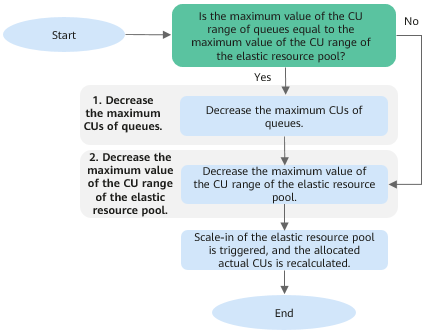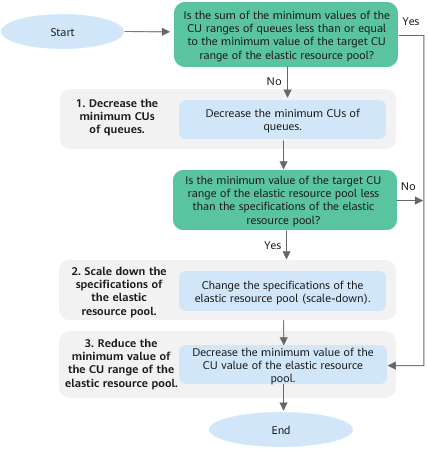Setting CUs
CU settings are used to control the maximum and minimum CU ranges for elastic resource pool scaling to prevent unlimited resource expansion risks.
For example, if the current maximum CUs of an elastic resource pool is 256 CUs, and two queues have been added with their scaling policies set to a minimum of 64 CUs each, attempting to add another queue requiring a minimum of 256 CUs would fail due to the constraints imposed by the maximum CU setting.
Basic Concepts Related to Elastic Resource Pools
The following introduces the basic concepts of actual CUs, used CUs, CU range, and specifications of an elastic resource pool.
Notes and Constraints
The minimum value of the CU range of the elastic resource pool cannot exceed the current actual CUs.
For example, if you want to raise the minimum value of the CU range (for example, from 64 CUs to 80 CUs), you must first ensure that the actual CUs are at least 80.
For methods on adjusting the actual CUs, refer to Scaling Out or In an Elastic Resource Pool.
Precautions
- In any time segment of a day, the total minimum CUs of all queues in an elastic resource pool cannot be more than the minimum CUs of the pool.
- In any time segment of a day, the maximum CUs of any queue in an elastic resource pool cannot be more than the maximum CUs of the pool.
- When adjusting the minimum CUs of a created elastic resource pool, the minimum CUs must be less than or equal to the actual CUs of the pool. Otherwise, the modification will fail.
- The adjustment of the CU range of a queue, the change of the elastic resource pool specifications, and the CU setting of an elastic resource pool take effect on the next hour.
- You can add queues to adjust the actual CUs of an elastic resource pool. The adjustment takes effect immediately.
Procedure
- In the navigation pane on the left, choose Resources > Resource Pool.
- Locate the row that contains the desired elastic resource pool, click More in the Operation column, and select Set CUs.
- In the Set CUs dialog box, set the minimum CUs on the left and the maximum CUs on the right. Click OK.

- Basic principles:
The minimum value of the CU range of the elastic resource pool must be less than or equal to the actual CUs. To increase the minimum value of the CU range beyond the current actual CUs, you must first scale out the elastic resource pool to raise the actual CUs.
When adjusting the minimum value of the CU range, if the target CU value is greater than the maximum value of the CU range, increase the maximum CUs of the elastic resource pool first.
This example describes how to adjust the target CU to be less than or equal to the maximum value in the CU range.
- Increase the actual CUs of the elastic resource pool by adjusting the maximum CUs of existing queues or adding new queues within the current elastic resource pool.
- Then, set the minimum value of the CU range to match the target CUs.
Figure 2 Flowchart for increasing the minimum value of the CU range of a pay-per-use elastic resource pool
- Example:
- Initial status:
- Actual CUs of the elastic resource pool: 64 CUs
- CU range of the elastic resource pool: 64 CUs to 96 CUs
- Objective: Adjust the CU range to 80 CUs to 96 CUs.
- Procedure:
- Increase the maximum CUs of queues or add queues so that the total maximum CUs of the queues are 80 CUs, triggering scale-out.
- After the scale-out, the actual CUs = max{(min[sum(maximum CUs of queues), maximum CUs of the elastic resource pool]), minimum CUs of the elastic resource pool} = max{(min(80, 96)), 64 CUs} = 80 CUs.
- Adjust the CU range to 80 CUs to 96 CUs.
- Procedure:
- Initial status:
If the maximum value of the CU range of queues is set equal to the maximum value of the CU range of the elastic resource pool, then when reducing the maximum value of the CU range of the elastic resource pool, you need to first decrease the maximum value of the CU range of the queues. Then, reduce the maximum value of the CU range of the elastic resource pool through CU settings.
Note: In this case, the maximum value of the target CU range of the elastic resource pool should be greater than the minimum value of the current CU range of the elastic resource pool. Otherwise, you need to first lower the minimum value of the CU range of the elastic resource pool.
According to the actual CUs calculation formula, we can observe that decreasing the maximum value of the CU range of the queues and decreasing the maximum value of the CU range of the elastic resource pool both affect changes in the actual CUs. Refer to Actual CUs Calculation Formula for more information.
Actual CUs = max{(min[sum(maximum CUs of queues), maximum CUs of the elastic resource pool]), minimum CUs of the elastic resource pool}.
Thus, after decreasing the maximum value of the CU range of the elastic resource pool, there might be a period where the actual CUs exceed the maximum value of the CU range of the elastic resource pool. However, at the next full hour following the completion of the operation, the system will recalculate the size of the actual CUs according to the actual CUs calculation formula, thereby triggering scale-in of the elastic resource pool.

- Example
- Initial status:
- Actual CUs of the elastic resource pool: 96 CUs
- CU range of the elastic resource pool: 64 CUs to 128 CUs
- Maximum value of the CU range of queues: 128 CUs
- Objective: Adjust the CU range to 64 CUs to 80 CUs.
- Procedure:
- Decrease the maximum CUs of queues to 80 CUs.
- Adjust the CU range to 64 CUs to 80 CUs.
- An elastic resource pool scale-in is triggered at the next full hour. Actual CUs = max{(min[sum(maximum CUs of queues), maximum CUs of the elastic resource pool])} = max{80 CUs, 64 CUs}.
- Procedure:
- Initial status:
- Basic principles for lowering the minimum value of the CU range of a yearly/monthly elastic resource pool
For a yearly/monthly elastic resource pool, at the time of purchase, both the minimum value of the CU range and the actual CUs of the elastic resource pool are equivalent to the pool's specifications.
Constraints on the minimum value of the CU range of the elastic resource pool:
- The minimum value of the CU range of the elastic resource pool must be greater than or equal to the sum of the minimum values of the CU ranges of all its queues.
- The minimum value of the CU range of the elastic resource pool cannot be less than the pool's specifications.
Procedure to decrease the minimum value of the CU range:
- Lower the minimum value of the CU range of queues.
- Adjust the specifications of the elastic resource pool to match the minimum value of the desired CU range.
- Decrease the minimum value of the CU range of the elastic resource pool.

If the new specifications of the elastic resource pool become smaller than the actual CUs, the specifications are billed on a yearly/monthly basis, and the difference between the actual CUs and the specifications (actual CUs – specifications) is billed on a pay-per-use basis. To achieve more cost-effective billing, you are advised to either decrease the maximum CUs of queues, delete queues, or lower the maximum CUs of the elastic resource pool so that the pool's specifications match the actual CUs. This ensures that all actual CUs are billed on a yearly/monthly basis, resulting in overall cost savings compared to the original method. Detailed instructions can be found in Modifying Elastic Resource Pool Specifications.
Figure 4 Flowchart for decreasing the minimum value of the CU range of a yearly/monthly elastic resource pool
- Basic principles for lowering the minimum value of the CU range of a pay-per-use elastic resource pool
The constraint for the minimum value of the CU range of the elastic resource pool: the minimum value of the CU range of the elastic resource pool must be greater than or equal to the sum of the minimum values of the CU ranges of all queues.
Procedure to decrease the minimum value of the CU range:
- Lower the minimum value of the CU range of queues.
- Decrease the minimum value of the CU range of the elastic resource pool.
Figure 5 Flowchart for decreasing the minimum value of the CU range of a pay-per-use elastic resource pool
- Example for a yearly/monthly elastic resource pool:
- Initial status:
- Actual CUs of the elastic resource pool: 64 CUs
- CU range of the elastic resource pool: 64 CUs to 128 CUs
- Specifications of the elastic resource pool: 64 CUs
- Sum of the minimum values of the CU ranges of queues: 64 CUs
- Objective: Adjust the CU range to 32 CUs to 128 CUs.
- Procedure:
- Decrease the sum of the minimum CUs of the CU ranges of queues to 32 CUs.
- Change the specifications of the elastic resource pool to 32 CUs.
- Adjust the minimum value of the CU range to 32 CUs to 128 CUs.
- In this case, the actual CUs exceed the specifications of the elastic resource pool. The 32 CUs within the specifications are billed on a yearly/monthly basis, while the remaining 32 CUs (actual CUs – specifications) are billed on a pay-per-use basis.
- Initial status:
- Example for a pay-per-use elastic resource pool:
- Initial status:
- Actual CUs of the elastic resource pool: 64 CUs
- CU range of the elastic resource pool: 64 CUs to 128 CUs
- Sum of the minimum values of the CU ranges of queues: 64 CUs
- Objective: Adjust the CU range to 32 CUs to 128 CUs.
- Procedure:
- Decrease the sum of the minimum CUs of the CU ranges of queues to 32 CUs.
- Adjust the minimum value of the CU range to 32 CUs to 128 CUs.
- Initial status:
Feedback
Was this page helpful?
Provide feedbackThank you very much for your feedback. We will continue working to improve the documentation.See the reply and handling status in My Cloud VOC.
For any further questions, feel free to contact us through the chatbot.
Chatbot





